Hypermedia’s influence on business and social interaction
Hypermedia mediated interactions influence the lives of a large proportion of New Zealand society, from our schooling through to our social lives. This chapter describes a journey from the early ideas of hypermedia, through to the contemporary usage of the World Wide Web and potential future developments. As a society, we are continually bombarded with Internet mediated communications and we, in turn, have embraced these interactions in a wide arena. Email and web-based shopping, e-governance and more recently Web 2.0 based social networking are now integrated into our everyday life. Increasingly individuals of all ages are spending more time online, indicating a change in the mechanisms through which we choose to socialise and interact with others. In this discussion we highlight the past, present and future of the World Wide Web and illustrate the many facets of this technology that influence our lives.
The World Wide Web (WWW) is an Internet-mediated technology which has its roots in the 1940s. The first visionary was Vannevar Bush who worked for the US government. One of the first victims of information overload, he was able to propose a solution based on his technological experiences. His thinking still offers interesting insights for the information retrieval and manipulation field of today. As is so often the case, one person’s ideas sparked a chain of events leading to the first networked computer interaction, a series of technologies and finally the field of information retrieval itself.
Hypertext, hypermedia and its visionaries
Hypertext is the storage of information in a nonlinear fashion. It is claimed that hypertext allows the user to store information in a manner analogous to the way in which the human mind works, i.e. by association. These systems impose very few constraints on the way in which the user may access and store information. Along with these capabilities, the user can make associations or links between ‘chunks’ of information. This linking facility allows users to move freely between these chunks of information, as illustrated above, in a manner which best suits their purpose, whether they are carrying out a structured search or just browsing.

A hypertext graph.
Gardner 1991 after Conklin 1987
The origins of the concepts of hypertext and hypermedia lie in the thinking of Vannevar Bush in 1945, Engelbart in the 1960s and Nelson in the 1970s. Although many others have contributed to the development of these concepts, each of these three was a visionary looking at new ways of augmenting the human intellect.
Vannevar Bush is widely held as the first individual to have considered managing information with a tool similar to hypertext. Bush was the scientific advisor to President Roosevelt during the Second World War; his engineering background and the enormity of the task of mobilizing the United States to war are considered some of the driving forces behind the article he wrote in 1945, ‘As We May Think’, which contains many of the seminal elements of the current systems that we term hypertext.
In this article, Bush considers a mechanism named ‘memex’. This was a personal, mechanized file and library system, storing all manner of materials, communication and text, which can be retrieved with speed and flexibility. He envisaged a desk arrangement, with a screen, keyboard, buttons and levers to allow the projection and manipulation of the materials stored within it. Such material was to be stored on microfilm both purchased and locally encoded, thus making large works manageable, for example, ‘Encyclopedia Britannica reduced to the size of a match box’.
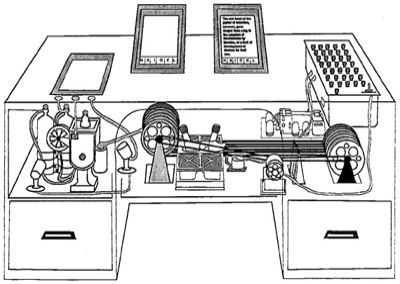
Memex.
Hofmoke 2009
Although Bush’s article is now over 60 years old, it has influenced the path of several developments in information systems that have occurred throughout the latter 20th and early 21st centuries.
Some 18 years later, Douglas Engelbart, whilst researching at the Stanford Research Institute (SRI), was influenced by Bush’s ideas and wrote an article entitled ‘A Conceptual Framework for the Augmentation of Man’s Intellect’. His ideas eventually led to the design of NLS (oN Line System) and several pieces of new hardware including the mouse.
The NLS system was the first recorded example of networked peer-to-peer computer interaction. In 1968 Engelbart demonstrated his peer-to-peer systems in what is now known as the ‘Mother of all Demos’. Although this project did not proceed much further, it was ground breaking as this was the first evidence that computers could be used to augment the human intellect, and the use of the network elements indicated an ability to have a collective or shared knowledge.
At the same time as Engelbart was developing his ideas of NLS, Ted Nelson was also developing ideas about augmentation. It was Nelson who coined the terms ‘hypertext’ and ‘docuverse’, and it is his thinking and writing which are the most far-sighted of the early work in this field. His dream was to create the Xanadu system, which would create a unified literary environment on a global scale. Nelson also worked with Andries Van Dam on the hypertext editing system. Though he was never able to attract sufficient funding to fully develop his ideas, his work provided much of the theoretical underpinning for the hypermedia environment of the present day. It is noted that recently a 3D link viewer, Xanadu Space, has been published.
The turning point in the early history of hypertext was brought about by Randal Trigg. He wrote the first PhD thesis on hypertext, describing his TextNet system. After finishing his thesis, Trigg joined Xerox PARC and was one of the principal architects of the Xerox NoteCards System.
The introduction of the affordable personal computer in the mid-1980s provided the catalyst for single unit nonlinear hypermedia systems to evolve. From this point a sudden explosion in interest and uptake of hypertext ideas occurred. There was a demand for a different way to store documentation rather than the conventional ‘flat files’ and ‘directory hierarchies’. Products with a much richer structure began to appear, such as LinkWay, NoteCards and HyperCard.
HyperCard was by far the product most commonly used by the general public. An Apple computer product, it was released as a tool to allow the individual to develop small stand alone systems. It contained basic graphics, special effects and all the basic hypertext features, e.g. linking and browsing. It also had an extendable object oriented programming language (HyperTalk) which allowed the system to develop as a multimedia product. The graphics and speed of the system were fast for the time; the object language interpreter behind HyperTalk actioned even complex code in good time. Although later editions of HyperCard did have some ability to access networks, this was missing in the first system, making such a system a very static product. Apple made the strategic decision to ship HyperCard free with every Apple Macintosh computer, thereby encouraging all new purchasers to use the system.
Other systems, which had to be purchased separately, were not as popular in the market place. HyperDoc and LinkWay were vigorously marketed, but only really used for small projects, for example Peugeot cars used HyperDoc to distribute a parts and instruction manual for the Peugeot 205 car range. IBM marketed LinkWay for $US100 but had few takers. By the late 1980s the use of free or low cost hypermedia systems was common in areas where the information was static in nature. Individuals began to investigate how static hypermedia could be used to access remote information.
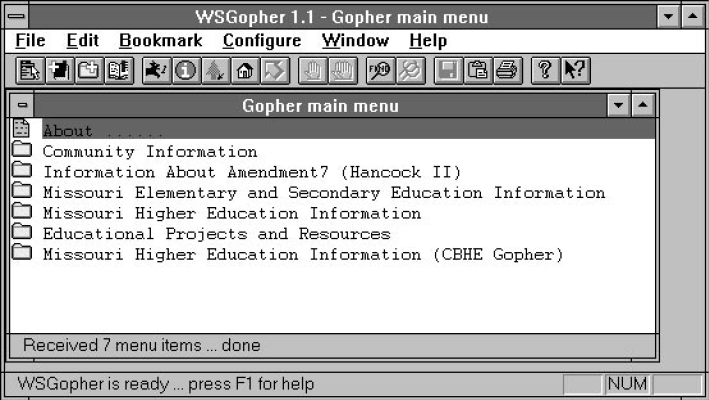
A basic example of a gopher client.
MOREnet 1994
The evolution to Internet mediated information retrieval and the WWW
The evolution of network based hypermedia systems was brought about through two popular information retrieval clients, Gopher and FTP, and the work of Tim Berners-Lee. His work in the late 1980s and early 1990s allowed such hypermedia systems to become tools for information retrieval, social discourse and electronic commerce.
The idea of a gopher was to allow information retrieval from remote servers using a range of protocols, e.g. FTP, UseNet etc. The gopher server allowed for the flexible retrieval of information in a hierarchical structure. Such servers and client software are still in existence today.
In the early to mid-1990s the WWW and gopher server technologies developed along similar pathways. In 1993/4 web pages frequently referenced gopher servers for further information retrieval. However, WWW servers were quickly able to duplicate the characteristics of such servers, and as browsing technology became more established, gopher servers went into decline.
Tim Berners-Lee is regarded as the individual who devised the ideas behind the World Wide Web. Prior to working at CERN (European Particle Physics Laboratory) he was concerned with the effort that it took to retrieve documentation. Having previously created a multiuser product called ‘Enquire’ to manage information on a software development product and also carried out research into semantic webs and hypertext ontologies, Berners-Lee brought his ideas together to propose the WWW as a way of improving access and document sharing.
The WWW exists to provide a mechanism for massive information exchange and retrieval. Endless information can be searched and accessed through the standard computer browser. Underlying this are several protocols and addressing systems that allow clients and servers to communicate. In order to effectively traverse the WWW, browsing clients were needed. Berners-Lee’s first attempt at such a system was ‘Enquire’, which was based on HyperCard and NLS. Subsequently, others produced more user-friendly software, the first of which was Mosaic in 1993.
During the early use of the WWW the growth of electronic commerce was hampered by the lack of security protocols and an inability to cope with large quantities of data. When large files were downloaded, or websites contained image intensive pages, the snail-like download speeds led to increasing levels of consumer frustration. The advent of broadband in many countries, together with the increasing power of web servers and the optimization of websites, meant these issues have gradually become less important. As the 20th Century drew to an end, many organisations were using web pages to advertise and generate demand for their products. In the initial stages most organisations purely used WWW for advertising, however, several online markets have subsequently appeared. Companies, especially the traditional catalog companies, saw the market potential and began selling electronically. US companies such as L.L.Bean and Lands End sell their entire range electronically while still maintaining their catalog business in parallel. In New Zealand, Ezibuys, Ballentynes and Dick Smith Electronics were quick to see the potential in the electronic marketplace. A number of the media groups also entered the web arena, the most notable being Stuff.co.nz.

The education and government sectors were also early adopters of the technology. For example, the University of Auckland began to facilitate students’ enrolment online through a web interface in 2000, thus cutting the enrolment administrative burden of the university by 90%.
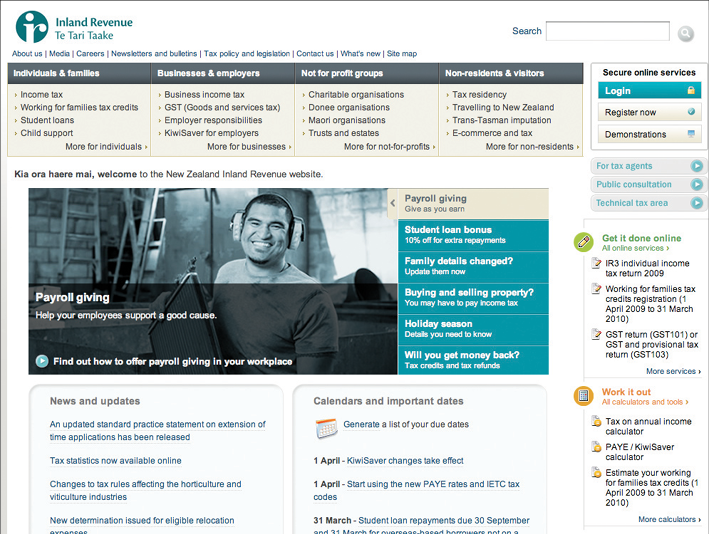
Governments have also been keen to use websites as a way of informing the public about rules and entitlements. It is notable that reports prepared for the Commonwealth as early as 2001 commented on the innovative use of the web in New Zealand, and government websites have received awards for their distinctive global identity and use of open source software. One of the most ground-breaking websites has been that of the Inland Revenue Department (IRD), which provides static information, forms in downloadable form, and interactive items such as the online services shown above.
Current status
In the late 1990s the uptake of WWW browsing technologies was phenomenal. This initial excitement led to widespread experimentation with the technology for electronic commerce. Barriers to entry were low, and start-up businesses known as ‘dot coms’ multiplied. Many were over optimistic about potential customer interest and, as the sector overheated, many businesses went bankrupt, leading to the dot.com crash of 2001.
Since that time the use of electronic commerce has matured. Organisations and individuals have continued to develop innovative ways of using the WWW, and these changes have begun to influence how we interact as social beings, how we find information and how we carry out day-to-day transactions.
These changes have been facilitated by higher speed access to the Internet; many consumers have access to broadband or high-speed networks for reasonable costs. The architecture which enables the construction and delivery of web content to a desktop, mobile or personal digital assistant (PDA) has advanced alongside a growth in consumer maturity when using the web. In many families nationwide the first point of search for information is now Google or Yahoo, and Google maps and its associated tools are used to find directions. We as individuals have become more comfortable with consumer tools to the extent that purchasing groceries online has become an appealing alternative to fighting our way around the supermarket at the weekend.
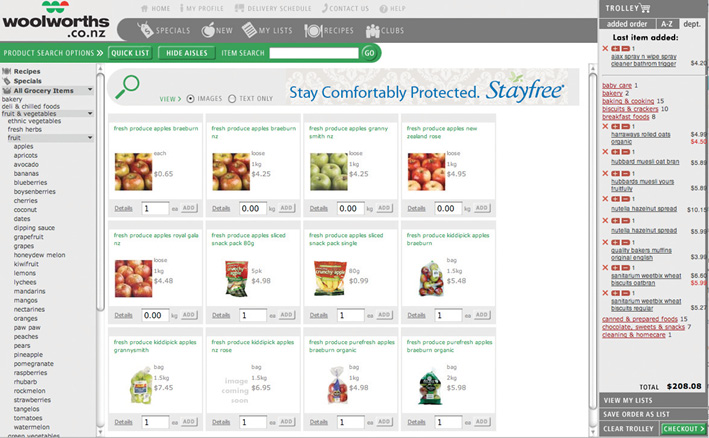
A typical Woolworths online shopping trolley.
End users are now actively adopting both push and pull technologies in order to access the web. A customer can pull information from the web by using a browser on a mobile device, such as an iPhone, to search for and purchase items and services at anytime from anywhere. Service technology is also increasingly being used to push information out to the end user, based on location, or profile.
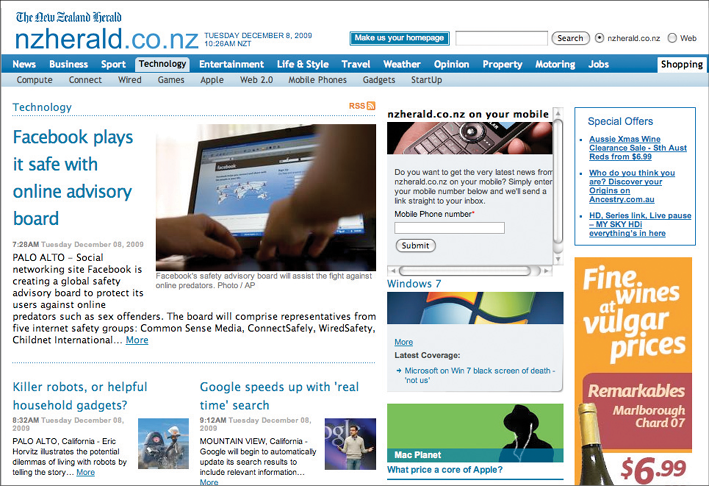
New Zealand Herald IT blog.
Such usage is made more interesting and also more straightforward by the underlying architectures and communication protocols that are now used to provide content to the end user. Such technology has evolved rapidly from the basic early HTTP protocol through the Document Object Model (DOM) now to be assisted by a range of additional technologies of which AJAX (for Asynchronous JavaScript + XML) appears to be the most favoured. When used together, the resulting web interfaces are more interactive and are widely referred to as Web 2.0.
Web 2.0 involves the use of a number of elements to increase user involvement and make content delivery livelier. Through enhanced capabilities on both the client and the server side, both the content itself and the method of delivery to the page has changed considerably. One result of these developments is the explosion in the use of blogs, wikis and social networking tools. There has been much discussion regarding the nature of these media, their relevance, trustworthiness and implications for governance. The data in these raw media often comes from an individual, is usually unedited and represents the ideas and beliefs of that particular person.
A blog or a web log is a mechanism that allows the individual to publish their ideas, thoughts or activities on regular or irregular time schedules. Blogs can be used, for example, by a business to keep the organization in touch with the CEO. They can also be used by the average person to publish their personal diary. Such blogs may contain a number of different media, from basic text through to podcasting.
Blogs are increasingly being picked up by the media; several newspapers now have particular blog features that run electronically beside the traditional publication media.
Blogs have led to the use of micro blogging sites such as Twitter, that allow the user to send short statements; these tweets are then picked up by any individuals subscribed to the tweeter. Other sites have attempted to bring micro blogging to the intranet; the most notable of these is Yammer. Yammer allows individual organisations to send micro messages to subscribed intra-organisational clients, with the aim of increasing discussion and information passing within the organisation.
Wikipedia, the online encyclopedia based on a wiki, has been criticised because its open access nature allows for the possibility of incorrect information being held. However, many organisations are finding that wikis are an ideal way to capture and share the knowledge of their employees. Document management tools, such as SharePoint, have web casting, blog and wiki support in order to assist the organization’s document management.
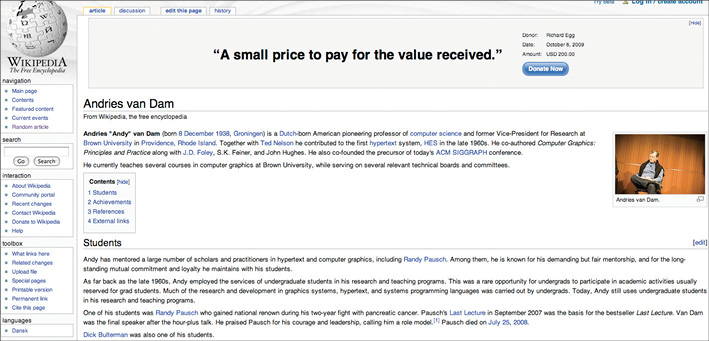
A Wikipedia page.
Wikipedia 2009
Traditional media outlets, such as targeted magazines, have also been quick to develop sites to complement their more traditional paper publications. In New Zealand the teenage female market is well catered for with multiple publications such as 24/7 Girl, Creme and Laety-Zine.
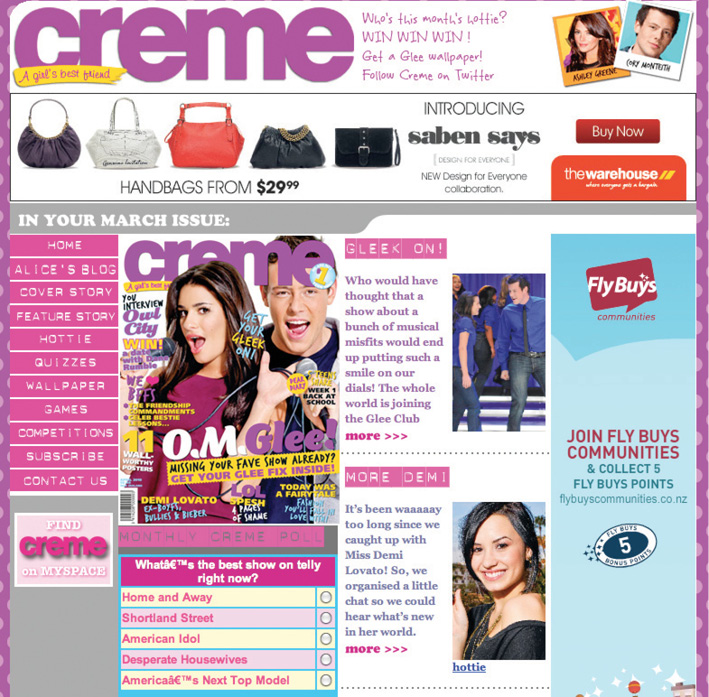
An example of a teenage girl’s online magazine.
The use of Really Simple Syndication (RSS) and podcasting has grown exponentially with the advent of the MP3 player, of which the iPod range is the most common. Given the ability to download materials from music to lectures there has been a stampede to release materials from BBC broadcasts to university lectures. The distribution of such RSS and podcasts is open, a large number of individuals use the iTunes software to subscribe to their favourite artists.
Where such hypermedia systems have become commonplace, electronic commerce is seen as a standard tool for business and the evolution of social networking and entertainment via such a network medium is inevitable.
There are still many issues to address around performance and security. The use of the Internet by business is limited by the performance of their machinery and the transmission speeds available to reach their clients. In New Zealand, a frequently recurring complaint is the speed and cost of networks. The case for high-speed coverage throughout New Zealand continues to be debated. Similarly, the ability to provide secure sites for transactions and security against server attacks has become increasingly important. As more reliance is placed on the web environment as a business tool, the risk associated with such endeavours increases; therefore, more precautions must be taken to ensure that business servers are secure and that the customer can feel confident when using the service provided.
Bulletin boards and user groups have been popular since the early 1980s; however, in recent years virtual community websites have increased their functionality dramatically, and the ability of individuals to congregate in the same electronic space is changing social behaviour.
Online social networks are widely used as a communication tool, diary or photograph album. People share their life, knowledge and experience in this media. Examples of social networking tools range from Twitter and MySpace, through to Facebook and Wretch.
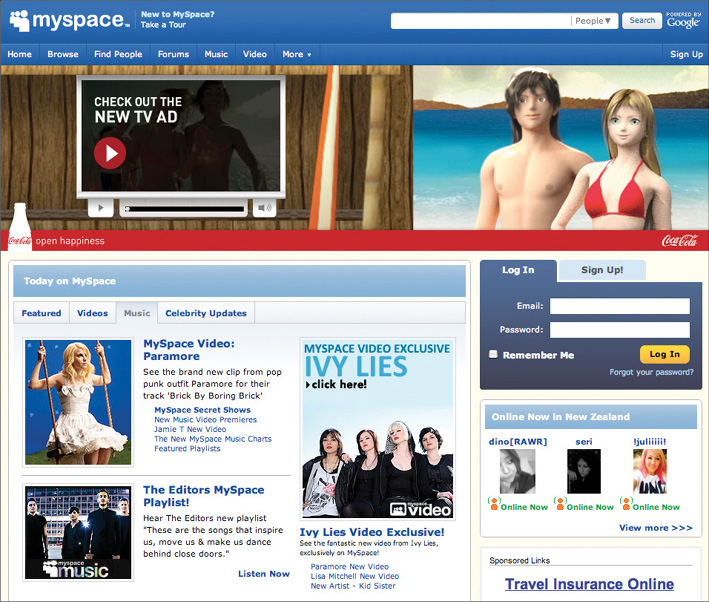

A Facebook gaming environment.
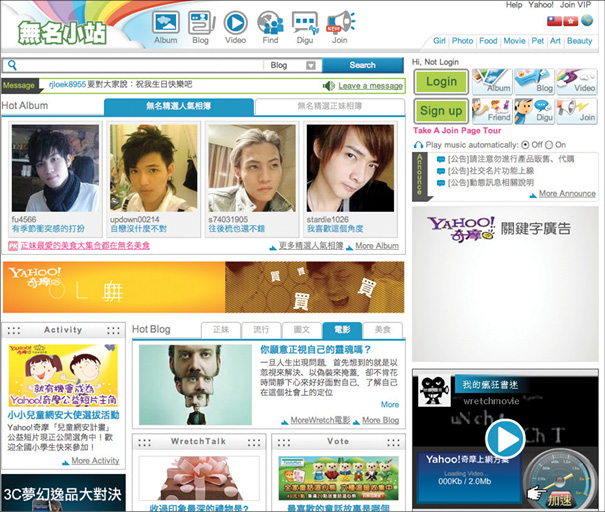
Wretch.
Such services are usually freely provided and rely on ‘ad sense’ style advertising to generate revenue. Many of these sites such as Facebook and Wretch provide additional game environments such as Farmville, which allow players interactive space, but also provide click through advertising space related to the players’ profile. For more motivated players they also offer mechanisms to add ‘real’ money to the systems.
Teaching and learning groups frequently experiment with the latest technological advances as a way of enhancing the learner’s journey. This is certainly the case with hypertext and the WWW. For example, the New Zealand Qualifications Authority (NZQA) sponsored site, Studyit, is a resource for all students studying the National Certificate in Educational Achievement (NCEA) program. Tools and learning management systems at tertiary education providers also provide Web based portals for learning and administration. The University of Auckland has designed and constructed Cecil, a learning management system to assist with every element of course design and delivery.
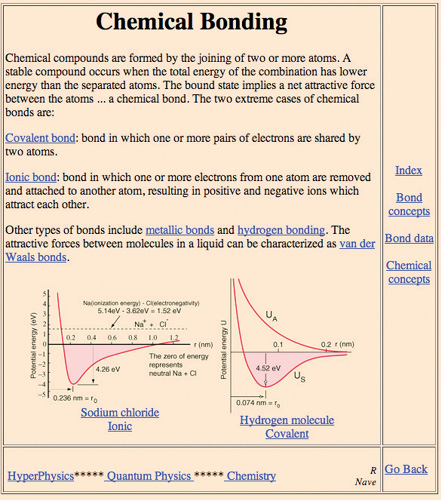
High school student study resources.
Studyit 2009
Globally, government bodies have been quick to adopt web based technologies in a bid to provide good access to government and transparent information. In developing countries the use of Internet kiosks means that people are able to access information in their own villages rather than making costly trips to the local government area offices. Here in New Zealand the use of web technologies helps to provide information and access to government at the local level. Each government agency now has a website; and research is being carried out developing a common interwoven web portal so that transparent information sharing can occur. Both education and government have made some ventures into using social networking tools. NZQA now offers the facility for students to receive a ‘tweet’ via twitter to remind them of their examination schedule. Government is also experimenting with intra-organisational social networking and a range of tools for public engagement. These range from wikis about new acts of parliament, such as The Police Act wiki, to cultural information blog services. The hope is that such technologies will empower the average citizen by providing good, reliable transparent information.

Cecil.
Cecil 2009
Both internationally and locally society is highly dependent on the Internet and the WWW for a wide range of information, commercial endeavours and games. Such web-mediated industry is founded on the basic tenants of hypertext but overlaid with a series of technologies and embellishments.
The future
The use of hypermedia has moved a long way from concepts first developed by Vannevar Bush to the current deployment of Web 2.0. This section outlines some areas of development that are growing and emerging as we look towards the future. It is likely that we will see a consolidation of technologies and the production of standards through which the consistency and stability of services will be ensured.
We are already seeing technological shifts to both mobile computing and web based desktops. With the decrease in mobile telephone costs and the increase in mobile phone capabilities, the trend to mobile web computing has already begun. As the speed and functionality of mobile devices, such as the iPhone, and mobile phone operating systems such as Nokia’s Symbian and Android improve, our connectivity and our ability to consume web services will increase. The advent of Wi-Fi-enabled handsets has also amplified interest in such technologies, as this reduces the operating costs even further. The device interfaces, their increased functionality and also their attractiveness to the consumer are important factors.
Web based technology in either desktop or handheld mode will increasingly affect our social interactions. There is anecdotal evidence that individuals’ social interactions are changing, as groups begin to congregate in social network and 3D environments such as Second Life. Socialisation in hypermedia-mediated systems is likely to increase. Fashion trends will dictate which sites become the most popular. As of 2010, there were some 2000 registered social networking sites ranging from discussion forums to games sites.
This change in the way we interact means that access issues will become more significant. If a consumer can’t afford the right device or pay the monthly fee to join the right network they won’t be able to participate; this will enable some groups and disadvantage others. The New Zealand Governments Digital Strategy attempted to address the issue of equal access to IT resources for all. The change in technology means that access strategies will now have to focus on the handheld device.
The ability of users to use a web browser as a desktop running their software from remote servers will increase. Content will be seamlessly delivered through services and integrated browser features allowing the end user to work unhampered. We are likely to see web services growing with an increasing ability to push information to us. With the inclusion of location services on many handheld devices, location based services and their supporting websites will become more significant. The future development of government portals will provide more personalised information and greater interaction.
The potential for business to leverage advantage from the WWW is impressive. Currently businesses tend to use the WWW as a shop front; in the future it is likely that more organisations will begin commercial ventures through websites. This will enable a business to use such technology for strategic positioning of products, for example being able to market a family of products. The frameworks and toolkits to facilitate this are already in place; the future will see the standardisation of such technology and future developments, which will in turn facilitate confidence in the commercial market.
In the education sector new developments will benefit the learner at all levels. Given the increasing sophistication of WWW technologies, educational environments will become more interactive and make greater use of games and simulations to improve learning.
Push technologies are likely to increase as an online services delivery grow in popularity. Such tools allow the business to inform customers of their goods and services; this allows businesses to stratify their marketing using customer data, and push this out to the desktop and also to the mobile handheld device. Such location and service software are likely to increase the personalisation aspects of the customer’s interaction with a business, as well as leading to reduced costs, thus allowing customisation for the individual as a business model. When looking for engagement with customers, it is also likely that the traditional attraction to a company website is likely to become less attractive with businesses using small adverts and links (similar to Ad sense) on websites which are considered to be cyber-magnets. Such links on regularly visited sites, e.g. Facebook, and Google’s search engine, are likely to provide good strategic nodes for web presence.
In order to facilitate these trends, there is increasing pressure to incorporate faster broadband and develop high-speed network infrastructure. It is anticipated that more service providers will enter the Internet service sector thus increasing competition and reducing price further.
Is the WWW about to evolve into Web 3.0? Here discussion revolves around the idea of the web browser becoming a form of assistant. Software will have integrated intelligent capabilities and be able to learn. In Web 3.0 the access of information, entertainment and commerce are seamlessly integrated to allow the user to get what they want with minimum effort. Some individuals argue that Web 3.0 is really the stabilisation and exploitation of Web 2.0. It is noted that there are some significant differences in browser style and the underlying semantic web ontology. It is proposed that there will be major evolutions which bring to fruition the coalescence of technologies first observed in the 1980s. This is a very exciting time for the evolution of the WWW; it indeed affects every aspect of our social, education and commercial lives.
In conclusion, we have travelled from the conceptual evolution of hypertext, the invention of the WWW and its effects on society, and now stand poised for the future. We have highlighted the past, the current and potential future as the use of servers and browsers becomes more sophisticated, and examined how these mechanisms are utilised for education, socialisation and in the business environment. The future for WWW environments looks bright; the period from 1945 through to 2010 has been innovative, exciting and ground breaking, and the next 25 years of hypermedia are eagerly anticipated with the implementation of intelligent agents, semantic webs and personal assistants already appearing on the horizon.
References/p>
24-7Girl (2010). Retrieved March 2010, from www.247girl.co.nz
Apple (2009). Retrieved December 2009, from www.bfc.co.nz
Ballentynes (2009). Home page. Retrieved December 2009, from www.bfc.co.nz
Bell, A, Crothers, C, Goodwin, I, Kripalani, K & Smith, P (2008). The Internet in New Zealand 2007 final report. Auckland: Auckland University of Technology
Bell, S (2009, 14 October). Collaboration through Web 2.0. CIO New Zealand
Berners-Lee, T (1989). Information management: A proposal. Geneva: CERN
Berners-Lee, T (1991). Multiuser considerations. Retrieved November 2009, from www.w3.org/DesignIssues/Multiuser.html
Bush, V (1945). As we may think. The Atlantic Monthly, 176(1), 101–108
Cecil (2009). Cecil web. Retrieved December 2009, from www.worldinternetproject.ne/login.aspx
Clift, S (2002). E-governance to e-democracy: Progress in Australia and New Zealand toward information-age democracy
Cole, J (2009). Annual Internet survey by the Centre for the Digital Future finds large increases in use of online newspapers, from www.worldinternetproject.net/publishedarchive/2009_Digital_Future_Project_Release_Highlights.pdf
Conklin, J (1987). A survey of hypertext
Creme (2010). Retrieved March 2010, from www.crememagazine.co.nz
Daiz, A (2007). Interaction between existing social networks and information and communication technology (ICT) tools: Evidence from rural Andes. Auckland: University of Auckland
Dick Smith Eletronics (2009). Home page. Retrieved December 2009, from www.dse.co.nz/dse.shop/
Dutton, WH, Helsper, EJ & Gerber, MM (2009). Oxford Internet survey, from www.oii.ox.ac.uk/microsites/oxis/publications.cfm
E-Government (2008). SSC wins open source award. Retrieved March 2010, from www.e.govt.nz/resources/news/2008/20080929.html/view?searchterm=award
Electronic Arts INC (2009). The Sims3, from www.thesims3.com
Engelbart, D (1963). A conceptual framework for the augmentation of man’s intellect. In PW Howerton & DC Weeks (Eds), Vistas in information handling (Vol. 1). Washington: Spartan Books
Engelbart, D (1968). Augmenting the human intellect demo, from www.youtube.com
EVAT (1995). Final report: MIT committee on EVAT — How is the Web likely to evolve?, from www-evat.mit.edu/report/future.html
Ezibuys (2009). Home page. Retrieved December 2009, from www.ezibuy.co.nz/Womens.html
Facebook (2009). Facebook gaming page. Retrieved December 2009, from www.facebook.com
Gadner, L (1991). Hypermedia for prototyping and system integration in information systems development. London: University of London
Gadner, L, Sheridan, D & White, D (2002). A web-based learning and assessment system to support flexible education. Journal of Computer Assisted Learning, 18(2), 125–136
Google (2009). Google home page. Retrieved December 2009, from maps.google.co.nz
Gronroos, C (2007). Service management and marketing — customer management in service competition. Chichester: Wiley
Hofmoke (2009). Untitled memex image. Retrieved December 2009, from atlas.colorado.edu/~hofmocke/digitalpoetry/images/memex.gif
IRD (2009). IRD home page. Retrieved December 2009, from www.ird.govt.nz/
Jong, S (1988). The challenge of hypertext. Paper presented at the 35th International Technical Communication Conference, Washington
Laety-Zine (2010). Top ten hottest magazine teen boys. Retrieved March 2010, from www.laety-zine.com/top-ten-hotest-magazines-teen-boys
LandsEnd (2010). Lands End. Retrieved March 2010, from www.landsend.com
Llbean (2010). LL Bean. Retrieved March 2010, from www.llbean.com
Madon, S (2009). E-governance for development: A focus on rural India. Basingstoke: Palgrave MacMillan
McKenna, B (2008). Development of a theory to enhance the use of consumer informaion systems. Auckland: University of Auckland
Media Awards (2007). NZ joint winner of global online identity award. Retrieved March 2010, from www.e.govt.nz/resources/news/2007/20070927.html/view?searchterm=award
MOREnet (1994). GOPHER. Retrieved December 2009, from www.more.net/
MySpace (2009). MySpace home page. Retrieved December 2009, from www.myspace.com
Nelson, T (1981). Literary machines: The report on and of project Xanadu, concerning word processing, electronic publishing, hypertext, thinkertoys, tomorrow’s intellectual revolution and certain other topics including knowledge, education and freedom. Washington
Nelson, T (2009). Xanadu space. Retrieved December 2009, from www.xanadu.com.au
Netscape (2010). Netscape archives. Retrieved March 2010, from browser.netscape.com
New Zealand Government (2009). Web 2.0 social networking tools. Retrieved December 2009, from www.e.govt.nz/resources/research/progress/agency-initiatives/chapter6.html
New Zealand Government (2010). NZ e-government interoperability framework. Retrieved March 2010, from www.e.govt.nz/standards/e-gif
New Zealand Herald (2009). Blog page for Herald. Retrieved December, 2009, from www.nzherald.co.nz/technology/news/headlines.cfm?c_id=5
New Zealand Police (2009). Police Act wiki. Retrieved December 2009, from www.policeact.govt.nz/wiki/
Nokia (2009). Nokia home page. Retrieved December 2009, from www.nokia.com
NZ Live (2009, December). Cultural entertainment. Retrieved from www.nzlive.com/blog/
Shadbolt, N & Berners-Lee, T (2008). Web science: Studying the Internet to protect our future. Scientific American, 299, 76
Sharepoint (2009). Microsoft sharepoint. Retrieved December 2009, from sharepoint.microsoft.com/social/features-and-benefits/Pages/SharePoint-Capabilities.aspx?CategoryId=6
Strickland, J (2009). How stuff works. Retrieved December 2009, from computer.howstuffworks.com/web-30.htm
Studyit (2009). Studyit home page. Retrieved December 2009, from www.studyit.org.nz/subjects/chemistry/chemistry1/5/
Stuff (2010). Stuff home page. Retrieved March 2010, from www.stuff.co.nz
Sun, J (2006). Exploring the relationship of social capital and knowledge exchange in virtual communities. Master’s thesis. University of Auckland. Auckland
Trigg, RH (1983). A network-based approach to text handling for the online scientific community: University of Maryland
Tsai, C (1988). Hypertext, applications and research issues. Journal of Educational Technology Systems, 17(1), 3–14
Tuunanen, T, Cassab, H, Gardner, LA & Bastek, M (2009, 29 October – 1 November). Service modularization: Reuse versus variation of service processes. Paper presented at the 18th Annual Frontiers in Service Conference, Hawaii
Twitter (2009). Home page. Retrieved December 2009, from twitter.com
van Dan, A (1988). Hypertext ’87 keynote address. Communications of the ACM, 31, 887–895
W3.org (2009). WWW consortium organisation. Retrieved December 2009, from www.w3.org
Wikipedia (2009a). An example of a Wikipedia page. Retrieved December 2009, from en.wikipedia.org/wiki/Andries_van_Dam
Wikipedia (2009b). An example of Wikipedia. Retrieved December 2009, from www.wikipedia.com
Woolworths (2009). Shopping cart. Retrieved December 2009, from www.woolworths.co.nz/HomeShopping/
Wretch (2009). Wretch home page. Retrieved December 2009, from www.wretch.cc
Yammer (2009). Yammer home page. Retrieved December 2009, from www.yammer.com